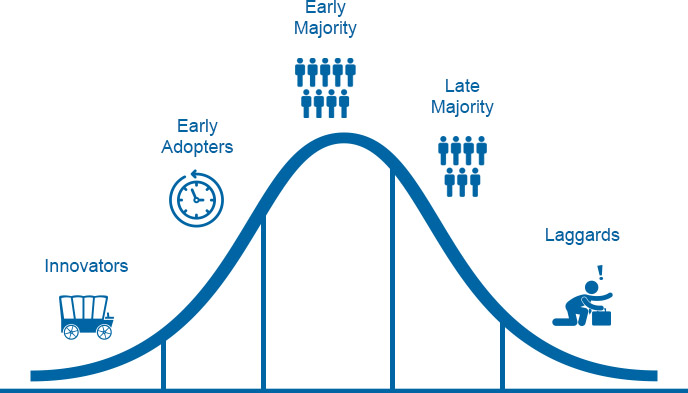
The Technology Adoption Curve in 2024: Key Insights for Business Leaders-As we navigate through 2024, the pace of technological advancement continues to accelerate, creating both challenges and opportunities for businesses. Understanding the Technology Adoption Curve is more crucial than ever for business leaders looking to stay ahead in a competitive landscape. This model not only outlines how new technologies are embraced but also provides insights into market behavior, consumer expectations, and strategic planning. Let’s dive into key insights from the Technology Adoption Curve that can help guide decision-making for leaders in today’s dynamic environment.
Understanding the Technology Adoption Curve

The Technology Adoption Curve, conceptualized by Everett Rogers, segments consumers into five categories based on their willingness to adopt new technologies:
- Innovators (2.5%): Tech enthusiasts who love experimenting with the latest advancements, often regardless of the risks involved.
- Early Adopters (13.5%): Visionaries who recognize the potential benefits of new technologies and are often seen as opinion leaders.
- Early Majority (34%): Pragmatic users who wait for proven effectiveness before making a change.
- Late Majority (34%): Skeptical individuals who adopt technology only when it becomes mainstream or necessary.
- Laggards (16%): The most resistant to change, laggards adopt new technologies only when they are forced to do so.
In 2024, understanding these segments can empower business leaders to tailor their strategies effectively.
Key Insights for Business Leaders

1. Embrace Innovation Early
In an age where technology evolves rapidly, staying ahead means embracing innovation early. Innovators and early adopters are vital for testing and refining new products. Business leaders should focus on cultivating relationships with these groups to gain valuable feedback.
Actionable Tip: Create pilot programs or beta testing phases to engage early adopters. Their insights can help shape product features and marketing strategies, paving the way for wider acceptance.
2. Leverage Social Proof
Social proof plays a significant role in influencing the Early Majority. This group tends to rely on the experiences of earlier adopters before making decisions. Therefore, showcasing testimonials, case studies, and success stories can be a powerful strategy.
Actionable Tip: Develop a robust marketing campaign that highlights positive reviews and experiences from early adopters. This approach can create a ripple effect, encouraging the Early Majority to embrace your technology. (Read More: Adapting to Change: The Role of the Technology Acceptance Model in Digital Transformation)
3. Focus on User Education
In 2024, the complexity of many new technologies can intimidate potential users, particularly among the Early Majority and Late Majority. Educating these groups about the practical benefits and ease of use of your technology is critical.
Actionable Tip: Invest in comprehensive educational resources, such as webinars, tutorials, and user manuals. By making it easier for consumers to understand your technology, you can alleviate fears and encourage adoption.
4. Adapt to Market Readiness
Understanding the current market readiness is crucial for timing your product launches. In 2024, with the rapid pace of technological change, market conditions can shift quickly. This makes it essential to continuously assess consumer needs, competitive landscape, and economic factors.
Actionable Tip: Conduct regular market research to gauge interest and readiness. Use surveys and focus groups to understand consumer perceptions and adapt your strategies accordingly. (Read More: Cutting-Edge Aviation Technology: Enhancing Safety and Efficiency in Air Travel)
5. Prepare for Resistance
Late Majority and Laggards can be resistant to new technologies. Addressing their concerns proactively can make a significant difference in adoption rates. This group often requires substantial evidence and reassurance before making a switch.
Actionable Tip: Highlight ease of use, cost-effectiveness, and long-term benefits in your marketing. Providing trial periods or guarantees can also help ease potential users’ concerns.
Emerging Technologies to Watch in 2024

1. Artificial Intelligence (AI)
AI continues to be a transformative force across various industries. From customer service chatbots to predictive analytics, its applications are growing rapidly. The adoption curve indicates that while innovators have embraced AI, the Early Majority is beginning to catch on, especially in sectors like retail and healthcare.
Business Implication: Leaders should consider investing in AI technologies that enhance operational efficiency and customer experience to capitalize on this growing trend.
2. Remote Collaboration Tools
The shift to remote work has led to a surge in demand for collaboration tools. As companies adapt to hybrid work environments, these technologies are becoming essential. Early adopters have paved the way for broader acceptance among the Early Majority. (Read More: How the Technology Acceptance Model is Shaping User Adoption in 2024)
Business Implication: Companies should prioritize investing in user-friendly collaboration tools that cater to the evolving needs of remote teams.
Conclusion article The Technology Adoption Curve in 2024: Key Insights for Business Leaders
As we progress through 2024, the Technology Adoption Curve provides a valuable framework for understanding market dynamics and consumer behavior. For business leaders, the key to success lies in embracing innovation early, leveraging social proof, educating users, adapting to market readiness, and preparing for resistance.
By applying these insights, leaders can effectively navigate the complexities of technology adoption and position their organizations for long-term success. In this rapidly evolving landscape, the ability to anticipate trends and respond strategically will be the hallmark of effective leadership. Embrace the lessons from the Technology Adoption Curve, and watch your business thrive in the digital age.




